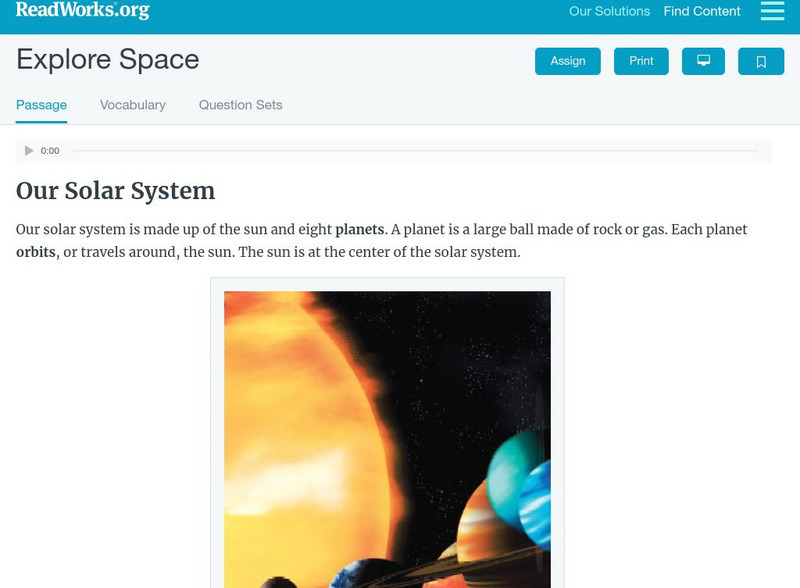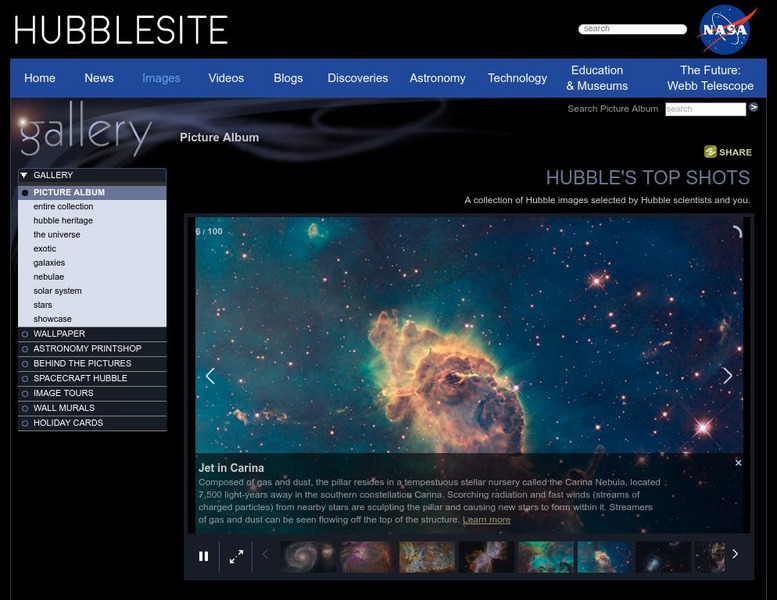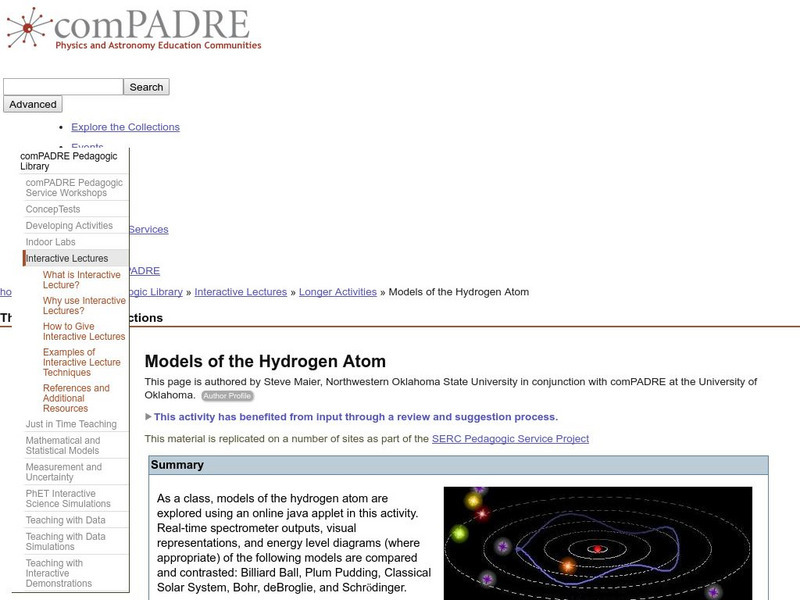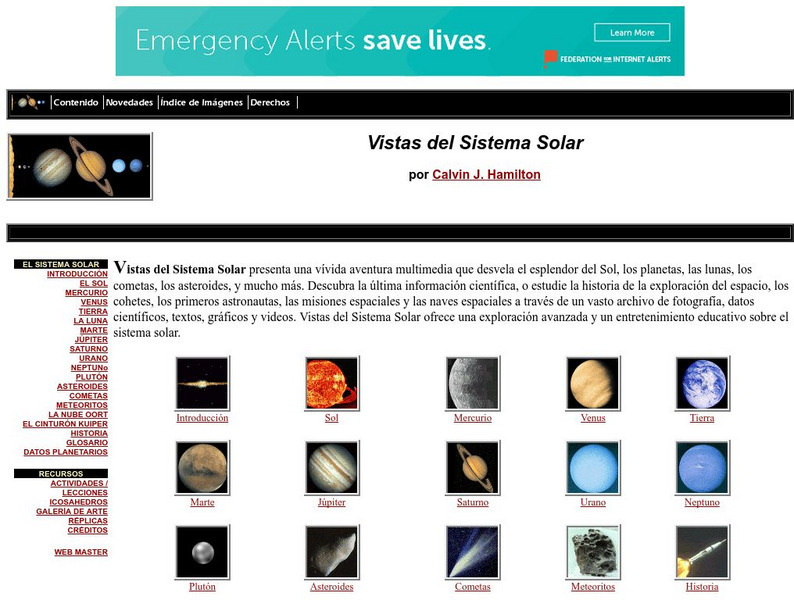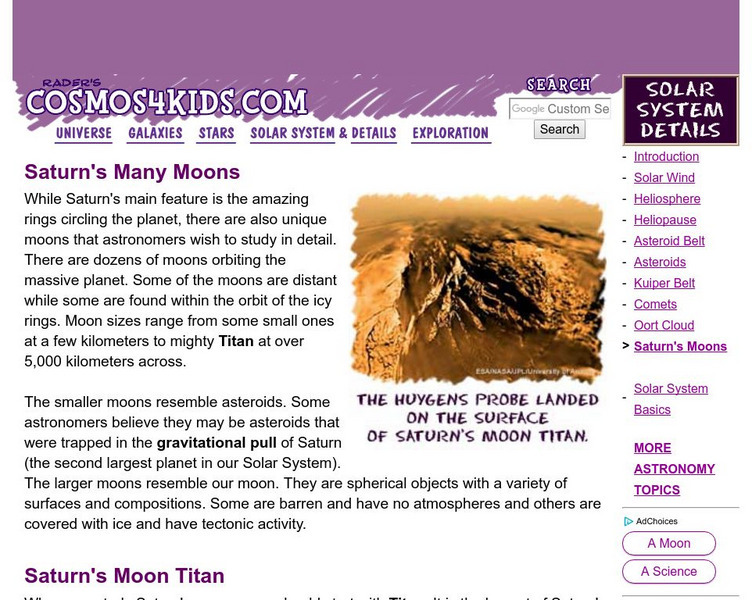Hi, what do you want to do?
Read Works
Read Works: Explore Space
[Free Registration/Login Required] This informational text passage shares information about the planets in the solar system. This passage is a stand-alone curricular piece that reinforces essential reading skills and strategies and...
Space Telescope Science Institute
Amazing Science: Solar System Trading Cards
Amazing Science looks at the Solar System with this FAQ site and lesson plan.
NASA
Nasa: The Space Place: Planet X Treme Weather
Ever wonder what the weather is like on other planets besides Earth? This resource explores the extreme weather that occurs on other planets.
Smithsonian Institution
National Air and Space Museum: Exploring the Planets: Earth's Lithosphere
The plate tectonics and other features of the Earth's lithosphere are explained and illustrated. Has links to definitions of the magnetosphere, atmosphere, and hydrosphere.
Enchanted Learning
Enchanted Learning: The Planets
This survey of the planets includes all the basics, size, mass, atmosphere, length of day, and the like. It features interactive activities and learning exercises and compares all of the planets in colorful tables.
TeachEngineering
Teach Engineering: Capturing the Sun's Warmth
In the exploration of ways to use solar energy, students investigate the thermal energy storage capacities of different test materials to determine which to use in passive solar building design.
NASA
Nasa: Space Place: I See Ice Viewer
Explore the solar system like never before with this photograph viewer. Choose the planet, then scroll through the many beautiful photographs taken by space missions. Read about how each photo shows evidence of the presence of ice.
Exploratorium
Exploratorium: A Guide to Astronomy Resources
A portal to resources on the sun, the Earth's neighboring planets, and the weather in space. Find out why Saturn is the "jewel of the Solar System" and explore what happens when Venus and Mercury make their rare transits across the sun.
Space Telescope Science Institute
Hubble Site: Images From Space
This site provides vivid images taken in space by the Hubble Telescope. You can view the entire collection or choose an area you enjoy the most. Explore galaxies, the solar system, nebulae and more!
American Geosciences Institute
American Geosciences Institute: Astronomy
Eight hands-on lessons module in which students explore the characteristics of planet Earth, its moons, the sun, the solar system, planets, and the difference between science fact and science fiction.
Utah State Office of Education
Utah State Office of Education: How Did the Universe and Solar System Develop?
Explore this unit to learn how the universe began. Through illustrations, videos, and classroom activities, gain an understanding of how stars help with the formation of elements.
Cosmos 4 kids
Cosmos4 Kids: Solar System Details: Kuiper Belt
Explore space beyond Pluto in the Kuiper Belt region of our solar system. Find out about the space bodies that exist there and what our space missions have taught us about this far away region.
ArtsNow
Arts Now Learning: Phases of the Moon [Pdf]
In this lesson, 4th graders use their bodies to model the day/night cycles of the Sun and Earth. Next, they discuss the moon's role in the solar system and explore the eight phases of the moon by acting out a story. Finally, a song...
Khan Academy
Khan Academy: Web Links
Web links to explore information about the solar system and Earth.
PBS
Pbs Teachers: Math Space Odyssey: The Capacity of the Planets
Use this activity to teach students to represent numbers in scientific notation, and use geometry to solve problems related to three-dimensional figures. Explore distance and capacity problems about planets in the solar system. The...
ClassFlow
Class Flow: Solar System Quiz
[Free Registration/Login Required] This is an assessment flipchart that explores the location of planets in our solar system.
NASA
Nasa: Jet Propulsion Laboratory: Planet Quest: Exoplanet Exploration
Constellation of articles, images, diagrams, posters, videos, and more on the subject of the search for planets, particularly Earth-like planets, outside our solar system.
American Museum of Natural History
American Museum of Natural History: Ology: Astronomy: In Pictures: Beyond Planet Earth
What would it be like to travel across the solar system and explore space? Take a look at some of the places that humans might go to someday, and the questions that scientists are asking.
Science Education Resource Center at Carleton College
Serc: Models of the Hydrogen Atom
In this activity, students will explore several different models of the hydrogen atom and compare and contrast them using an online java applet.
NASA
Nasa: The Space Place: What's in the Heart of a Comet?
NASA site explores what a comet's nucleus is composed of. Animation and photographs are provided as well.
Views of the Solar System
Solarviews: Vista Del Sistema Solar
This site offers an exploration and educational entertainment about the solar system. You will be able to study the history of the exploration of space, rockets, the first astronauts, space missions through a large archive of photos,...
Cosmos 4 kids
Cosmos4 Kids: Solar System Details: Moons of Saturn
Explore the dozens of Saturn's moons orbiting the second largest planet of our solar system. Find out about the Cassini space mission which explored Saturn's largest moon, Titan.
Cosmos 4 kids
Cosmos4 Kids: Solar System Details: Oort Cloud
Explore the huge spherical region surrounding our solar system. Find out what the Oort Cloud contains and how comets originate there.
National Geographic
National Geographic: Design Your Own Space Probe
A science activity for tween students using science and engineering skills to design a space probe to explore the solar system with. Complete lesson plan is provided to guide classroom work.





